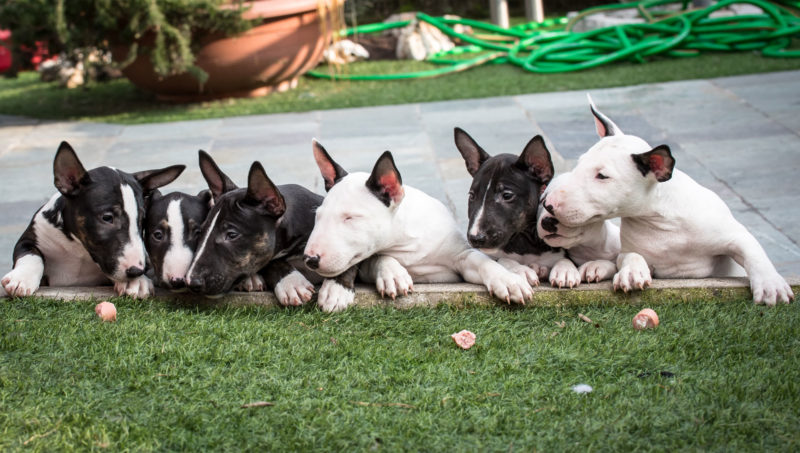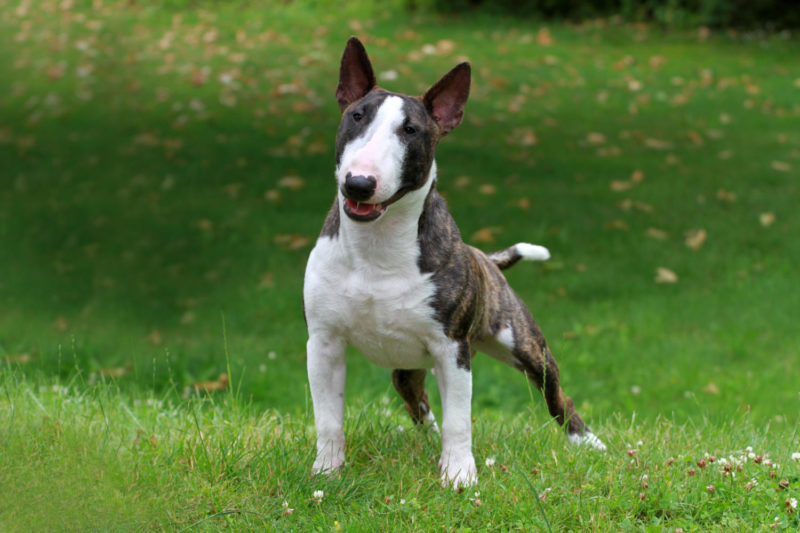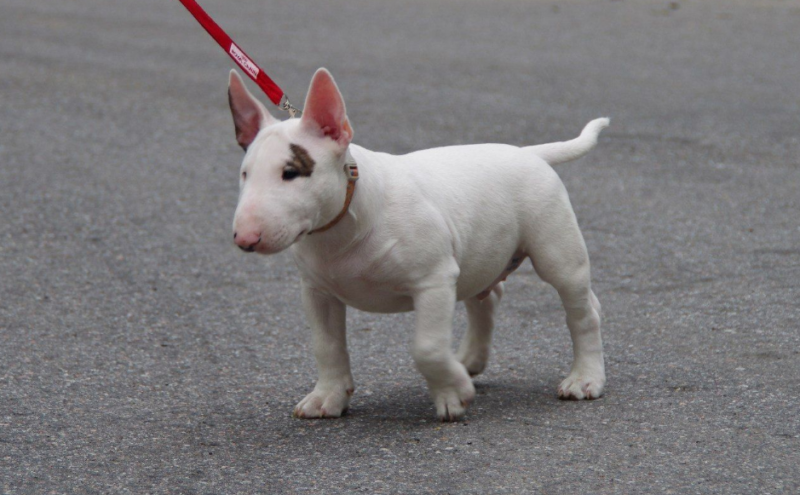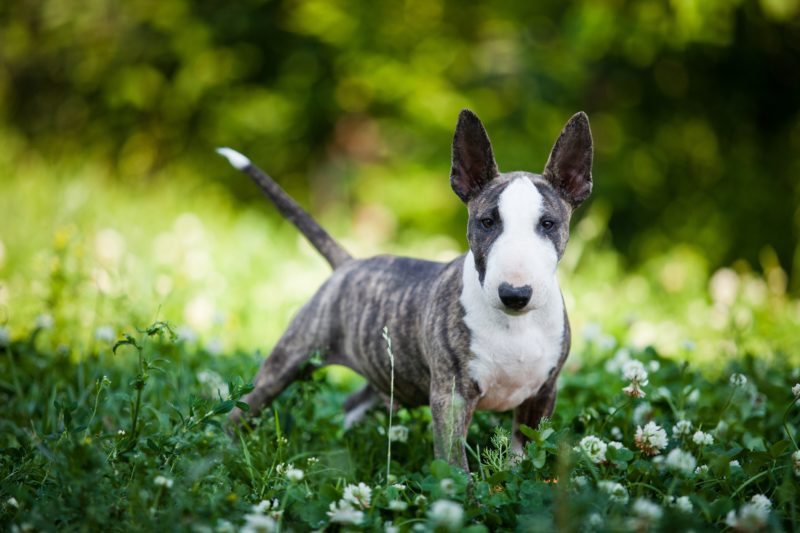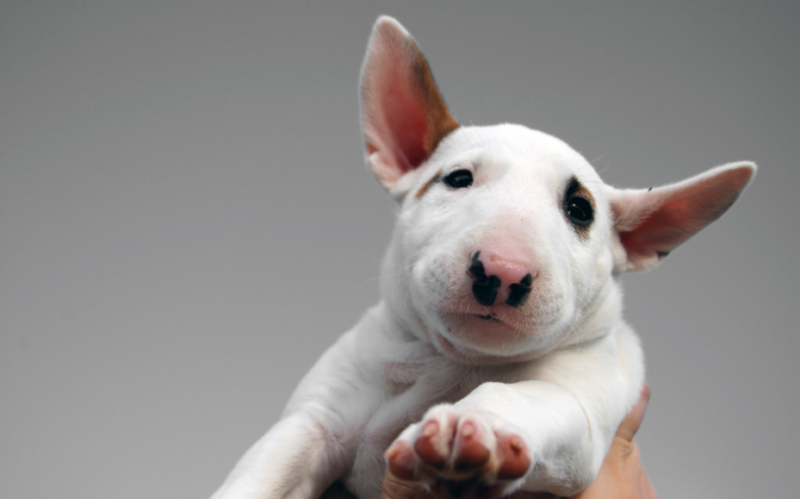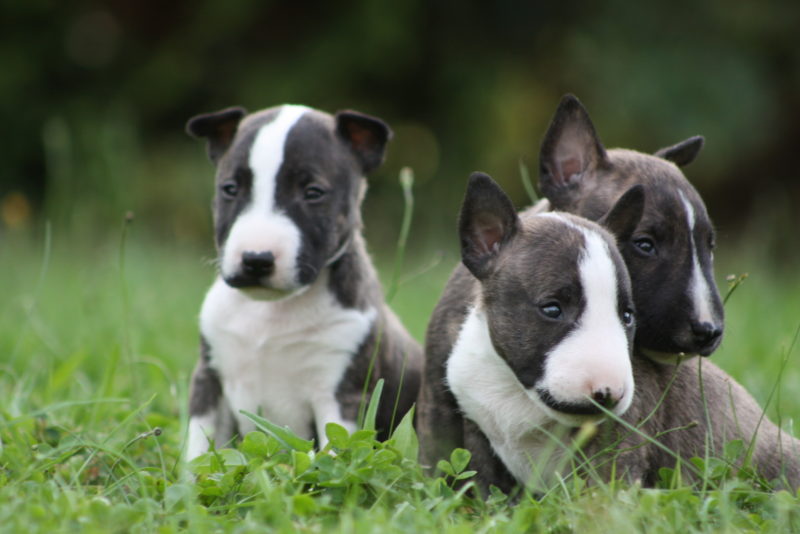A charming mini-bull terrier is the closest relative of ordinary bulls who have earned such formidable fame around the world. Reduced copies of bull terriers that appeared as a result of breeding work quickly gained popularity and love among admirers of this breed. How to care for a little doggie, and what are the features of his character?
Material Content:
Description and nature of the breed variety
Before you purchase a tiny dog and make it your pet, it is recommended that the potential owner study the description of the breed variety in detail.
In principle, the mini-bull breed standard provides the same requirements that apply to regular bull terriers:
- The shape of the head of the animal must certainly be elongated with a flat upper part and a strong lower jaw.
- The body of small bullets is slender, muscular.
- Straight legs are parallel to each other.
- The chest is powerful.
- The nose and eyes of small bull terriers must certainly be a dark shade.
- The average weight of the mini-bull terrier is 11–15 kg, and its height is 25–35 cm.
Little Bull is a representative of shorthair dog breeds. Despite their rather modest size, the whole appearance of these animals speaks of strength and endurance. The transitional part from nose to forehead is absent in small bull terriers, the ears are small, the tail is thick and short. The eyes are shaped like an apple, and their cut is triangular.
The standard allows for tiger, brown, black and white colors of animals.White bull terriers with spots in the head area are also not considered to be marriage.
Origin history
A miniature bull terrier made itself known in the 19th century - at that time the breed was bred in the UK. The first attempts to create a mini-copy of the bull terrier were made by crossing white terriers and English bulldogs. Subsequently, in addition to the bulldogs, the Dalmatians also joined the mixing. The result of such selection experiments was the appearance of the "elder brother" of a mini-bull - a bull terrier. From the total number of animals, the smallest individuals were selected, whose blood was then mixed with the blood of toy terriers, Jack Russell terriers and fox terriers.
In the 20th century, breeders worked hard to improve the mini-bull. The current representatives of this breed differ from ordinary bull terriers only in size. All other parameters are fully saved.
It is interesting. In the 30s of the 20th century, a club for lovers of mini-bulls was created in Great Britain. The breed standard was formed in 1991, although the first exhibition of these dogs was recorded back in 1983.
Puppy selection criteria
Going to buy a puppy of a mini-bull terrier, you should pay close attention to the pedigree of the baby, as well as study the typical features of the breed. For mini-bulls, the presence of genetic pathologies of the kidneys, eyes and heart is characteristic. In addition, deafness often affects these dogs.
Watching puppies of a mini-bull terrier it is useful to pay attention to:
- skin of a doggie - they must be clean, on their surface there are no redness, crusts;
- ears and eyes should also be distinguished by cleanliness and grooming;
- bite - in healthy representatives of the breed, it must certainly be correct;
- the coat should look well-groomed, without traces of fleas and their excrement;
- nose - in the absence of any health problems, this part of the body is wet and cold.
Healthy bullterrier kids are playful, curious and funny.
Life span
As a rule, small bull terriers are in good health. The life expectancy of these dogs is, on average, 12 to 14 years.
To protect yourself from buying a potentially sick animal, you need to purchase puppies from trusted breeders with a good reputation. Professionals are picky about the choice of individuals for breeding, which avoids the manifestation of genetic diseases of the offspring.
Features of care and maintenance
The lack of undercoat and short hair of the mini-bull terrier are the main obstacles for this dog to live in the aviary.
Compact bullets are best kept in a house or apartment, protecting them from the cold in every way.
In the autumn-winter period, these dogs often catch a cold, which is the reason for the occurrence of multiple health problems.
In general, the miniature bull terrier is a rather unpretentious creation:
- The basic care measure is to periodically comb out the coat to remove dead undercoat (1 time per week).
- Ears of boules should be systematically examined, from time to time clearing them of pollution.
- You should also cut the claws of the animal as they grow.
- Too often it is not necessary to bathe a bull terrier - only in process of pollution of a fur. In the warm season, it is enough to wipe the body of the pet with a damp cloth.
Dog Feeding Rules
It is permissible to feed a mini-bull terrier dog with both dry food and natural food. It is recommended to choose ready-made feed marked “extra-class”.
Regardless of the type of food chosen, several key recommendations should be considered:
- The animal should be fed at the same time - this disciplines the bull terrier. It is best to treat the pet at the end of the walk, because having lunch, he will probably want to relax. You should not indulge the bull terrier in his quest to beg something from the master's table.
- When building a pet’s diet, his age should be taken into account, especially with regard to finished feed. The intricacies of the natural diet of small bulls should be discussed with the veterinarian.
- Miniature bull terriers must not be overfed. Excessive gluttony can lead to obesity, which causes health problems. Until the pet reaches 7 months of age, it is fed four times a day, by the year the number of meals should be 2 times a day.
- A bowl of clean fresh water should be in the vicinity of the pet.
Bull terriers are very fond of asking for pieces of goodies from the owner. Sometimes it is very difficult to refuse a pet, looking into his devoted sad eyes. However, the owner must remember: various sweets and smoked meats can cause irreparable harm to the dog’s health.
If the desire to treat your pet is very strong, you can limit yourself to a small piece of carrot.
Characteristic diseases
Since this breed is considered to be artificially bred, some specific diseases can affect mini-bull terriers:
- destruction of the patella;
- primary dislocation of the lens;
- aortic stenosis;
- hypoplasia of the trachea.
In order to avoid possible problems with the pet’s health, an attentive owner should systematically monitor his condition, turning to a veterinarian for help.
Timely vaccination will help reduce the risk of many diseases that affect four-legged pets.
Parenting and training
Initially, small bull terriers were bred for hunting rats - the small dimensions of these animals helped them easily cope with this task. Over time, from the hunters these dogs turned into pets.
There is an opinion that the bull terrier is a potentially dangerous breed of dog, regardless of size. This fear is most likely rooted in the past: bull terriers often became participants in dog fights. In addition, the appearance of these animals really inspires respect, and sometimes even apprehension. In view of all of the above, it is understandable that the fear of some people was transferred to the "younger brother" - a miniature bull terrier.
And although the small bull is a dog, it’s really difficult and requires patience and perseverance on the part of the owner, with the proper education of these animals they are distinguished by a cheerful disposition, poise, and discipline.
Such dogs are completely devoid of aggression towards humans.
And yet, in the process of training boules, one should not forget that these animals have strong jaws and impressive teeth. In combination with the wrong approach to training and the explosive temperament of the dog, all this can make the mini-bull terrier dangerous for other animals, and sometimes people.
The “younger brother” of the bull terrier is truly donkey stubborn and striving for leadership. For this reason, the process of education should begin from the very first days of the appearance of the pet in the home. He must clearly understand his place, have a zone for food and rest. Do not let the bule sleep in the same bed with the owners.
During a walk, the young bull terrier should be physically loaded, with the passage of time moving to training. The animal must obediently obey the owner, feel its superiority and leadership. You should also give the dog a basic concept of hierarchy in the family: the main ones are people, and then animals. Otherwise, the mini-bull can recognize only one family member as the owner, ignoring the rest or even literally terrorizing them.
Bull should be accustomed to walking on a leash and in a muzzle, ignoring other animals.
Important! In the process of training, one should not yell at bull terriers and certainly, one should not use physical force - this will only provoke the pet’s bitterness.
Pros and Cons of the Mini Bull Terrier
The acquisition of a miniature bull terrier as a pet has a lot of advantages, among which:
- ease of care for the dog's hair;
- sociability of a doggie;
- fidelity of the bull terrier to the owner;
- Great Pet Watching Skills.
However, before buying a puppy, one should take into account a number of features of the mini-bull breed, which many potential owners can consider as cons:
- aggressive behavior towards other animals;
- desire to dominate, independent disposition;
- the need for systematic walks and physical activity.
Also, do not forget that miniature bull terriers are not suitable for novice owners. These dogs should be opened exclusively to people with experience in training such animals.
Mini-bul is a faithful and loyal companion, which is also distinguished by excellent security qualities. However, do not forget that along with these pluses of the kids truly donkey stubbornness can distinguish. Having overcome this barrier, the patient owner will find a disciplined and obedient friend.


